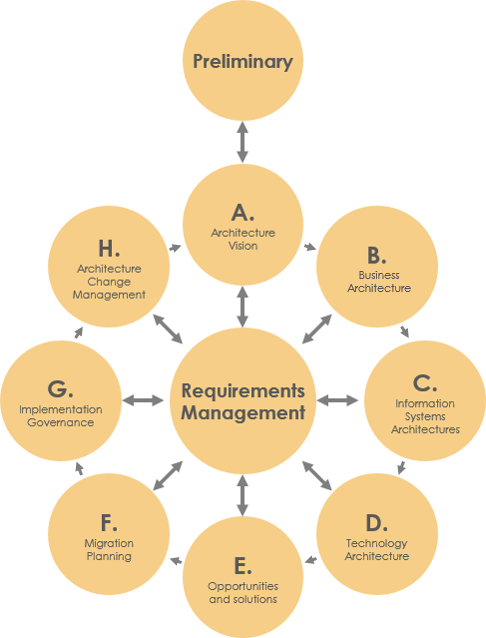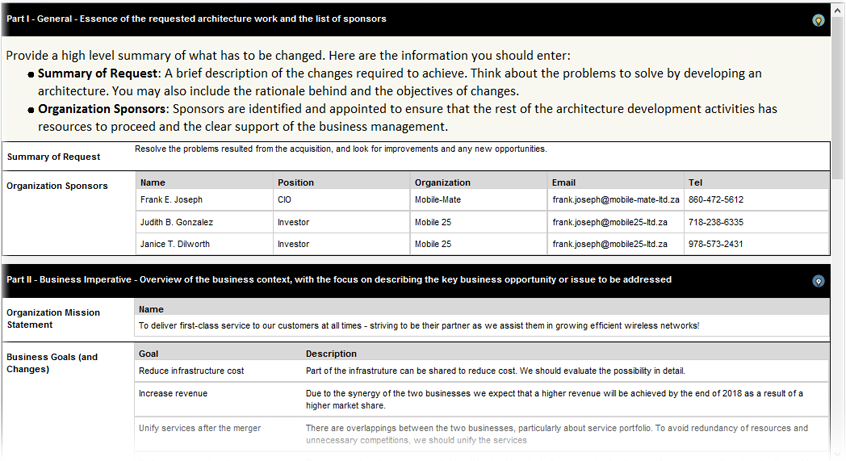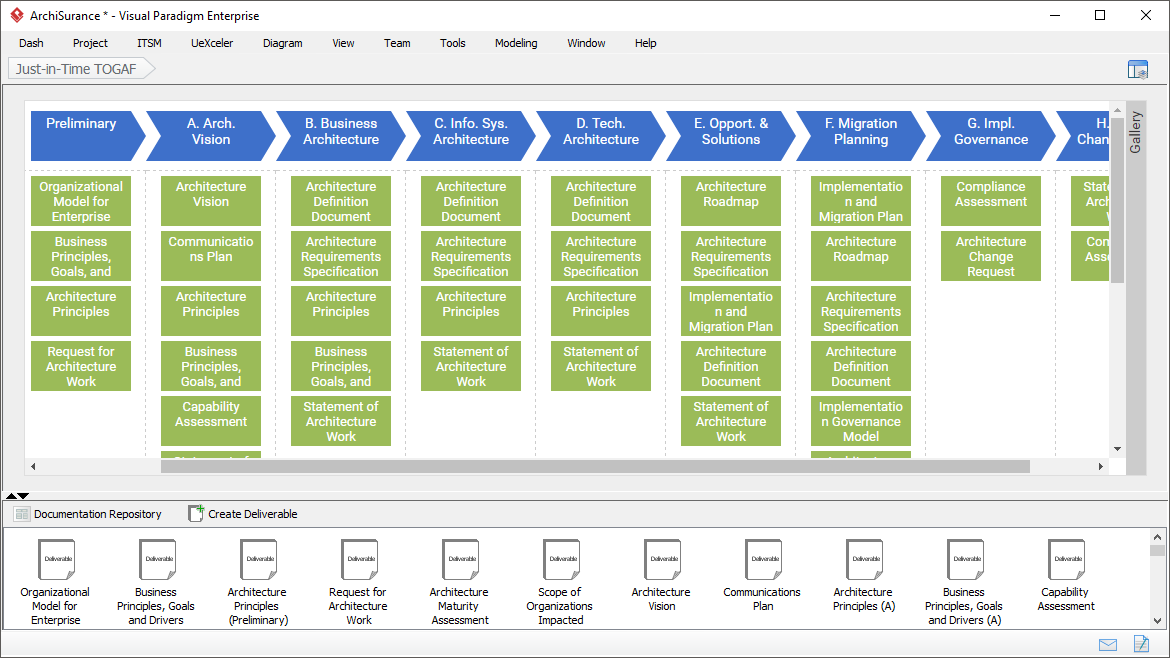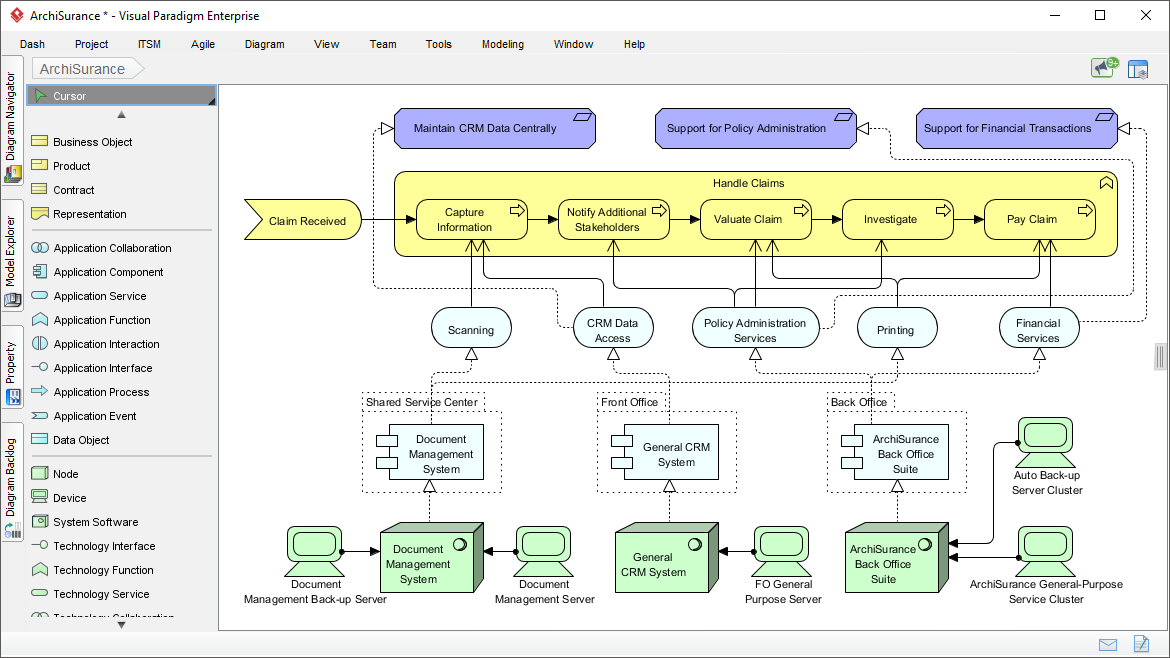TOGAF Guide: Why Every Enterprise Architect Should Know It?
TOGAF, or The Open Group Architecture Framework, is a widely used enterprise architecture framework that provides a comprehensive approach to designing, planning, implementing, and governing enterprise information systems. It provides a common language and methodology for enterprise architects to design and manage the architecture of an organization.
As an enterprise architect, it is essential to have a clear and consistent approach to architecture development and governance. TOGAF provides a framework for enterprise architects to align business and technology strategies, improve governance and management practices, enhance collaboration and communication among stakeholders, and facilitate continuous improvement. By using TOGAF, enterprise architects can ensure that their organization’s information systems are well-designed, aligned with business objectives, and able to support the organization’s growth and success.
This article will provide a comprehensive overview of TOGAF and its benefits for enterprise architects. We will explore the key components and elements of TOGAF, the benefits of using a common language and methodology, and how TOGAF can improve governance, collaboration, and decision-making. We will also cover the steps to get started with TOGAF and the resources available to help with implementation.
Objectives of the Article
The objectives of this article are to:
- Explain what TOGAF is and how it works
- Outline the benefits of using TOGAF for enterprise architects
- Provide real-world examples of organizations that have successfully implemented TOGAF
- Provide tips for overcoming common challenges and obstacles in implementing TOGAF
- Encourage enterprise architects to learn more about TOGAF and its benefits.
Background on TOGAF
History of TOGAF
TOGAF was first developed in 1995 by the Open Group, an international consortium of organizations dedicated to the development of open, vendor-neutral technology standards. Over the years, TOGAF has evolved and grown in popularity, becoming one of the most widely used enterprise architecture frameworks in the world. Today, it is used by organizations of all sizes and industries, from government agencies and large corporations to small and medium-sized enterprises.
Key Principles and Concepts of TOGAF
TOGAF is based on several key principles and concepts that are essential to effective enterprise architecture. These include the use of a common language and methodology, the alignment of business and technology strategies, the improvement of governance and management practices, and the facilitation of collaboration and communication among stakeholders. TOGAF also emphasizes the importance of continuous improvement, encouraging organizations to regularly evaluate and improve their enterprise architecture to stay ahead of changing business and technology requirements.
Overview of the TOGAF Standard and its Components
The TOGAF standard is a comprehensive framework that includes a range of components and elements designed to support enterprise architects in all aspects of architecture development and governance. These components include the architecture development method (ADM), the architecture repository, and a range of supporting tools and resources. The ADM is a step-by-step process that guides architects through the development and implementation of the enterprise architecture. The architecture repository is a centralized location for storing and sharing architecture information and artifacts, including models, views, and meta-models. The supporting tools and resources include guidelines, templates, and best practices for using TOGAF in practice. Together, these components provide a complete and consistent approach to enterprise architecture, helping enterprise architects to design, plan, implement, and govern their organization’s information systems.
What is TOGAF and How Does it Work?
The Key Components and Elements of TOGAF
TOGAF consists of several key components and elements that work together to provide a comprehensive approach to enterprise architecture. The components include the Architecture Development Method (ADM), the Architecture Repository, and Supporting Tools and Resources.
The Architecture Development Method (ADM) is a step-by-step process that guides architects through the development and implementation of the enterprise architecture. The ADM is divided into several phases, each of which is designed to address a specific aspect of the architecture development process.
The Architecture Repository is a centralized location for storing and sharing architecture information and artifacts. It includes models, views, and meta-models that provide a common language and methodology for the organization’s enterprise architecture.
Architecture Development Method (ADM) and its Phases
The architecture development method (ADM) is the core of TOGAF and provides a step-by-step approach to architecture development. The ADM is divided into the following phases:
- Preliminary
- Phase A: Architecture Vision.
- Phase B: Business Architecture.
- Phase C: Information System Architecture.
- Phase D: Technical Architecture.
- Phase E: Opportunities and Solutions.
- Phase F: Migration planning.
- Phase G: Implement governance.
Each of the phases is designed to address a specific aspect of the architecture development process, from the creation of the architecture vision to the implementation of governance practices. The ADM provides a structured approach to the development of the enterprise architecture, helping enterprise architects to ensure that their work is aligned with business goals and priorities.

Architecture Repository and its Components
The architecture repository is a centralized location for storing and sharing architecture information and artifacts. It includes models, views, and meta-models that provide a common language and methodology for the organization’s enterprise architecture. The components of the architecture repository include:
- Architecture Models: Detailed descriptions of the organization’s architecture, including business, data, application, technology, and operations architecture.
- Architecture Views: Different perspectives on the architecture, including business, data, application, technology, and operations architecture.
- Meta-Models: Descriptions of the relationships and interdependencies between the architecture models and views.
The architecture repository provides a single source of truth for the organization’s enterprise architecture, allowing enterprise architects to collaborate and communicate effectively. By using the architecture repository, enterprise architects can ensure that their work is aligned with business goals and priorities and that their architecture is continuously improved to meet changing requirements.
Why Should Every Enterprise Architect Know How to Use TOGAF?
TOGAF provides a common language and methodology for Enterprise Architecture
One of the primary benefits of using TOGAF is that it provides a common language and methodology for enterprise architecture. This enables enterprise architects to collaborate and communicate effectively with each other and with stakeholders from other departments and teams within the organization. By using a common language and methodology, enterprise architects can ensure that their work is aligned with business goals and priorities, reducing the risk of miscommunication and misunderstandings.
TOGAF helps align business and technology strategies
Another important benefit of using TOGAF is that it helps to align business and technology strategies with the enterprise architecture. By using the architecture development method (ADM) and the architecture repository, enterprise architects can ensure that their work is aligned with business goals and priorities, improving the overall effectiveness of the organization. This also helps to ensure that technology investments are aligned with business strategies, reducing the risk of misaligned investments and improving the overall return on investment.
TOGAF improves governance and management practices
TOGAF also provides a framework for improving governance and management practices within the organization. The architecture development method (ADM) provides a structured approach to the development and implementation of the enterprise architecture, ensuring that architecture work is aligned with business goals and priorities. The architecture repository provides a single source of truth for the organization’s enterprise architecture, enabling effective governance and management practices.
TOGAF enhances collaboration and communication among stakeholders
TOGAF also enhances collaboration and communication among stakeholders, including enterprise architects, business leaders, and technology specialists. By providing a common language and methodology for enterprise architecture, TOGAF enables stakeholders to work together effectively, reducing the risk of miscommunication and misunderstandings. This improves the overall effectiveness of the organization and helps to ensure that enterprise architecture work is aligned with business goals and priorities.
TOGAF facilitates continuous improvement
Finally, TOGAF provides a framework for continuous improvement of the enterprise architecture. By using the architecture repository, enterprise architects can track changes and improvements over time, facilitating continuous improvement of the organization’s enterprise architecture. This helps to ensure that the enterprise architecture remains aligned with business goals and priorities and is continuously improved to meet changing requirements. By using TOGAF, enterprise architects can ensure that their work is effective, efficient, and aligned with business goals and priorities, improving the overall success of the organization.
How TOGAF Can Benefit Your Organization?
TOGAF can significantly benefit your organization by improving efficiency and alignment. By providing a common language and methodology for enterprise architecture, TOGAF enables enterprise architects to work more effectively and efficiently, reducing the risk of miscommunication and misunderstandings. The architecture repository also helps to ensure that the organization’s enterprise architecture is aligned with business goals and priorities, improving the overall effectiveness of the organization.
TOGAF also plays a critical role in better decision-making and increased agility. By providing a framework for the development and implementation of the enterprise architecture, TOGAF enables enterprise architects to make informed decisions that are aligned with business goals and priorities. This also helps to ensure that technology investments are aligned with business strategies, improving the overall return on investment. Furthermore, by providing a framework for continuous improvement, TOGAF enables the organization to respond quickly and effectively to changing requirements, increasing overall agility.
TOGAF can also improve stakeholder engagement and buy-in. By providing a common language and methodology for enterprise architecture, TOGAF enables stakeholders from different departments and teams to collaborate and communicate effectively, reducing the risk of miscommunication and misunderstandings. This also helps to ensure that enterprise architecture work is aligned with business goals and priorities, improving overall stakeholder engagement and buy-in.
Many organizations have successfully implemented TOGAF, including large enterprises, government agencies, and non-profit organizations. For example, the United States Department of Defense has implemented TOGAF to improve the alignment of its technology investments with business goals and priorities, increasing overall efficiency and effectiveness. Another example is a leading financial services organization that implemented TOGAF to improve the alignment of its technology investments with business strategies, resulting in improved decision-making and increased agility. These are just a few examples of the many organizations that have successfully implemented TOGAF to improve the alignment of their technology investments with business goals and priorities, increasing overall efficiency and effectiveness.
How to Get Started with TOGAF
Getting started with TOGAF can seem like a daunting task, but it is actually quite straightforward with the right approach. Here are the key steps to take to start using TOGAF in your organization:
- Assess your organization’s current architecture landscape and identify areas for improvement.
- Familiarize yourself with the TOGAF standard and its components, including the architecture development method (ADM) and architecture repository.
- Create a project plan for implementing TOGAF, including a timeline and budget.
- Develop a governance structure to ensure that TOGAF is properly maintained and updated over time.
- Establish a clear and consistent methodology for using TOGAF in your organization, including roles and responsibilities, standards, and processes.
There are numerous resources and tools available to help with the implementation of TOGAF, including:
- The Open Group website, which provides a wealth of information, including white papers, case studies, and training materials.
- TOGAF training courses, which provide hands-on instruction and guidance on how to use TOGAF effectively.
- Enterprise architecture software, which can automate and streamline many of the tasks involved in using TOGAF, such as architecture repository management and ADM tracking.
Here are some tips for overcoming common challenges and obstacles when implementing TOGAF in your organization:
- Involve key stakeholders in the implementation process to ensure buy-in and support.
- Foster a culture of continuous improvement and be willing to adapt your approach as needed.
- Communicate the benefits of TOGAF clearly and consistently to ensure that everyone in the organization understands the value it provides.
- Be patient and allow time for the benefits of TOGAF to become apparent. The process of aligning business and technology strategies takes time and requires consistent effort, but the results are well worth it.
Visual Paradigm: Enterprise Architecture Software
Implementing the ADM can be a complex and time-consuming process, and organizations often struggle to fully realize the benefits of TOGAF. This is where Visual Paradigm comes in, as it provides a comprehensive solution for supporting the TOGAF ADM.
Visual Paradigm is a leading EA tool that provides a comprehensive solution for modeling, visualizing, and managing EA. It supports multiple architecture frameworks, including TOGAF, and it provides a range of features to support the TOGAF ADM. Some of the key features of Visual Paradigm include:
- Step-by-step approach: Visual Paradigm provides a step-by-step approach for implementing the TOGAF ADM, making it easier for organizations to understand and follow the ADM process.
- Architecture modeling: Visual Paradigm provides a range of architecture modeling tools, including UML, BPMN, and ArchiMate, to help you model your EA.
- Architecture visualization: Visual Paradigm provides a range of visualization tools to help you view your EA, including diagrams, charts, and reports.
- Architecture management: Visual Paradigm provides a range of tools for managing your EA, including version control, change management, and impact analysis.
Visual Paradigm supports enterprise architecture with TOGAF by offering three main features:
-
TOGAF ADM Guide-Through: An ADM process management tool that guides you through the activities of an ADM cycle. Each activity requires you to perform certain actions, which include but are not limited to form filling (e.g. create a Statement of Architecture Work) and diagram creation (e.g. create a Work Breakdown Diagram). The information entered is consolidated in forming the TOGAF deliverables.

-
Just-in-Time TOGAF Process Map: A matrix of TOGAF activities. Each activity involves a set of steps, and each step consists of action item(s) you need to perform to get the activity done.

-
ArchiMate modeler: Create enterprise architecture models using Visual Paradigm’s ArchiMate diagram tool. Certified by The Open Group, Visual Paradigm features an ArchiMate modeling tool that is targeted toward all levels of enterprise architects and enterprise modelers, supporting architecture design needs with all the vocabulary, notation, syntax, and semantics of the ArchiMate 3.1.

Visual Paradigm is a full-featured modeling platform for creating ArchiMate models and other diagrams. It is used by Enterprise Architects from all over the world. Here is a shortlist of things you can do with Visual Paradigm:
-
Create ArchiMate diagrams
- Access to a full set of ArchiMate notations
- Use ArchiMate viewpoints
- Ensure the correctness of modeling syntax with syntax checking on-the-fly
- Easy-to-use drag-and-drop ArchiMate editing tool
- Quick diagram creation with the Resource-Centric interface
- Precise positioning of shapes with alignment guide
- Inline shape editing
- Alignment and distribute functions
- Rich set of formatting options
- Maintain ArchiMate model
- Group ArchiMate models by packages / model shapes
- Model traceability
-
Team collaboration
- Work with the EA teams and other modelers concurrently and collaboratively with team collaborative features
- Keep revisions for your ArchiMate diagrams
- Smart conflict resolution for conflicted changes
- Publishing / Sharing
- Publish and share ArchiMate diagrams online
- Export diagrams as image files
- Document creation
- Coverage of additional model types
-
TOGAF support
- Visual TOGAF ADM process map with actionable work items
- Produce deliverable as you progress through the enterprise architecture development cycle
- Additional Enterprise Architecture toolset
- DoDAF process map
- NAF process map
- MODAF process map
Conclusion
TOGAF provides a common language and methodology for enterprise architecture, enabling enterprise architects to align their business and technology strategies and improve governance and management practices. With its focus on continuous improvement and stakeholder engagement, TOGAF can help organizations achieve better efficiency, alignment, decision-making, and agility.
Whether you are just starting out with enterprise architecture or are looking to improve your existing practices, TOGAF is a valuable tool to have in your arsenal. With the right resources and support, implementing TOGAF can be a straightforward and rewarding process. We encourage all enterprise architects to learn more about TOGAF and its benefits and to consider how it can help your organization achieve its goals.
References
List of relevant sources and resources for further reading on TOGAF:
- The Open Group Architecture Framework (TOGAF) Website (https://www.opengroup.org/togaf)
- “TOGAF 9.2 Enterprise Architecture Development Method” by The Open Group (https://pubs.opengroup.org/architecture/togaf9-doc/arch/)
- “TOGAF 9 Foundation Study Guide, 3rd Edition” by Rachel Harrison (https://www.amazon.com/TOGAF-Foundation-Study-Guide-3rd/dp/0124103983)
Additional resources for implementing and using TOGAF in practice:
- The Open Group Architecture Forum (https://www.opengroup.org/ogsys/forum/architecture)
- TOGAF Training Courses offered by The Open Group (https://www.opengroup.org/training/courses/togaf)
- “The Architecture Development Method (ADM) Handbook” by The Open Group (https://pubs.opengroup.org/architecture/togaf9-adhb/arch/)
- TOGAF Templates and Tools offered by The Open Group (https://www.opengroup.org/togaf/templates-tools)

